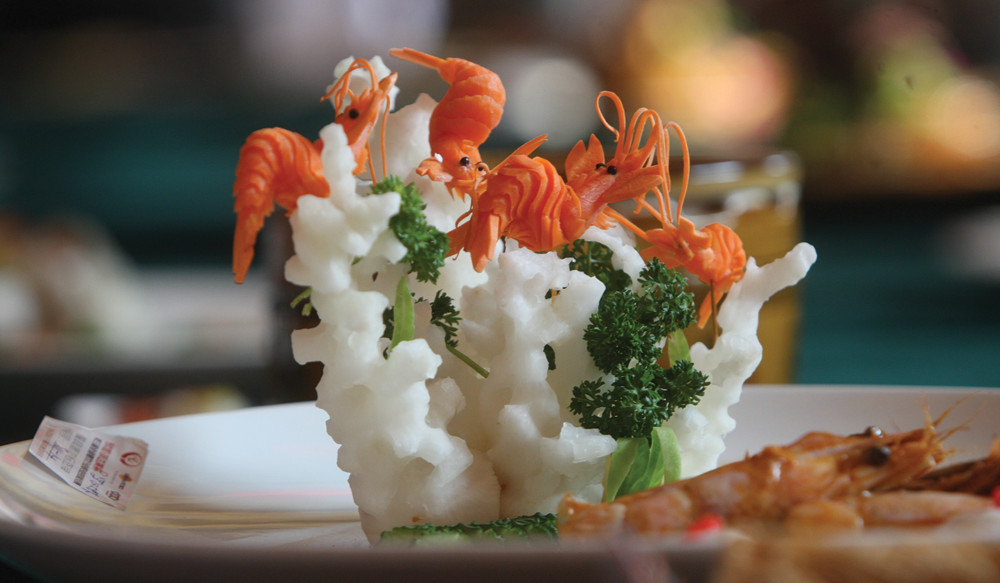Chinese Cuisine: Edible Artwork
The first time I paid attention to the beauty of food was brought about by a friend. Before then, when selecting food at the market I always first thought of the taste of that food. But my friend said he first looked whether the food was beautiful or not. Only if he thought the food was beautiful enough then he would buy it. Ever since then I have started to notice the aesthetic aspect of food.
The emphasis on the aesthetics of dishes is a distinguishing feature of Chinese cuisine. Chinese people call delicious food 美食 (Mĕishí). Mĕi (美) means beautiful, shí (食) means food. In Chinese culture, the beauty of food not only refers to the taste but also indicates the colour, shape, aroma and texture. The harmony of all of the elements, which is essential in Chinese food, makes a Chinese dish beautiful food.
Colour and shape are especially important staples of Chinese cuisine. The colours in Chinese dishes originate from the natural food colours. One dish should have a main colour and supporting colours used for highlighting the main colour. For example, ‘Chicken slice with lotus’(芙蓉鸡片 Fúróng Jīpiàn) has a white chicken slice as the main colour; the supportive colours are green from green vegetables and red from red sausages. It makes the dish colourful and harmonious. Colours can be divided into warm colours and cold colours. Warm colours like yellow and red make people excited, stimulating the eater’s appetite, which also helps to add a festive atmosphere. When the Miao minority people celebrate the Sister’s Festival (姐妹节 Jiĕmèi Jié) in Guizhou province (贵州省), white rice is dyed into rainbow coloured rice with local herbs, making the food look as happy as the people’s mood is. Cold colours like green, blue and purple usually function as supporting colours.

Copyright: Xinhua
The beauty of food shapes is that it brings visual pleasure, increases the eater’s appetite and inspires people to appreciate the beauty of life. With the development of Chinese cuisine, the skill of shaping Chinese dishes has also improved. There are several ways to shape Chinese dishes, for instance, food carving(食雕 Shídiāo), piecing cold food together (冷拼 Lĕngpīn) and dough modelling(面塑 Miànsù). Food carving is the art of carving food to look like different things, such as flowers, birds and scenery. Piecing cold food together is the art of shaping different colourful food materials into vivid patterns, which resembles children’s playing blocks. This dish is usually the first course which has the function of highlighting dining themes. Dough modelling is a festival custom in the northern part of China. It has thousands of years of history in China, and it is quintessentially beautiful and delicious. In Shandong province (山东省), on wedding days relatives and friends of the young couple usually make fried dough models as wedding presents. Common shapes are dragons, phoenixes and other lucky animals, representing good wishes. In the south of Shanxi province (山西省), grandmothers usually make round steamed dough models for their grandchildren on their birthdays. There are various different patterns for the round dough modelling, such as flowers, Chinese zodiac animals and Chinese characters, representing wishes of the children’s good health.
The names of Chinese dishes are even more beautiful than the shapes and colours. Chinese people pay close attention to the names of dishes and their meaning. Names of Chinese dishes are interesting and meaningful because they not only show the features and meaning of dishes but are also full of Chinese wisdom. Some names are derived from the colours of the food materials, e.g. ‘Pearl and agate jade soup’ (珍珠玛瑙翡翠汤 Zhēnzhū Mănăo Fĕicuì Tānɡ) is the beautiful name for a kind of Chinese soup made of tofu, tomatoes and green vegetables. People can imagine the beauty of the soup just from the name. Some names come from Chinese idioms or folk legends, e.g. stir-fried squid and chicken is called ‘Dragon playing with phoenix’ (游龙戏凤 Yóulónɡ-xìfènɡ) which is a romantic folk legend, making the dish full of with cultural connotations.
A delicious Chinese dish can bring various enjoyments in spirit and physicality, which is also the harmony of all visual, acoustic, gustation and olfactory senses. Chinese cuisine is more than the food meeting the essential physiological need, it is the edible artwork containing harmonious Chinese culture and neutralising aesthetic ideal.
By Teng Jiaqi (滕嘉琪)
 Share on Facebook
Share on Facebook Share on Twitter
Share on Twitter Share on LinkedIn
Share on LinkedIn